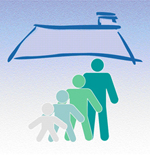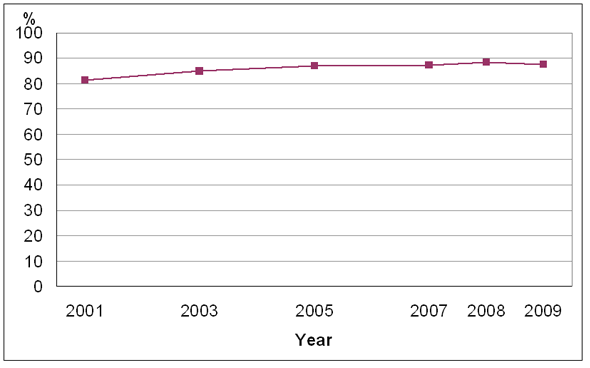Breastfeeding, 2009
Archived Content
Information identified as archived is provided for reference, research or recordkeeping purposes. It is not subject to the Government of Canada Web Standards and has not been altered or updated since it was archived. Please "contact us" to request a format other than those available.

The World Health Organization (WHO), Health Canada and the Canadian Paediatric Society recommend breastfeeding as the best method of feeding infants because it provides optimal nutritional, immunological and emotional benefits for growth and development.
Women aged 15 to 55 who had given birth from 2005 to 2009 were asked, in 2009, about breastfeeding experiences related to the birth of their most recent child.
Of those women, 87.5%, or 1.3 million, breastfed their most recent baby, if only for a short time. The percentage of women who initiated breastfeeding rose from 81.5% in 2001 to 87.0% in 2005, and has held steady since then (Chart 1).
Women with a postsecondary diploma or degree were more likely to begin breastfeeding their babies than those without a postsecondary diploma or degree (90.4% compared with 81.9%).
Of the 12.5% of new mothers who did not attempt to breastfeed, 28.4% cited medical factors (e.g., C–section, premature birth, multiple birth, or medical condition of mother or baby) as the main reason for not breastfeeding. An additional 24.6% said that breastfeeding was "unappealing" or "disgusting" and 19.5% said that bottle feeding was easier.
Chart 1
Percentage who initiated breastfeeding, household population women 15 to 55 who gave birth in the previous five years, Canada, 2001 to 2009

Source: Canadian Community Health Survey, 2001, 2003, 2005, 2007, 2008 and 2009.
Of those who did begin to breastfeed, 6.9% stopped after less than one week and by one month 21.4% had stopped. However, in terms of those who continued to breastfeed, 53.9% who initiated breastfeeding continued for six months or longer; 15.9% breastfed for more than a year.
The proportion of mothers who began to breastfeed was above the national average in Alberta (92.4%), British Columbia (97.3%), and Yukon, where all the women who were interviewed in 2009 had begun to breastfeed. The proportion of women who began to breastfeed was below the national average in Newfoundland and Labrador (61.1%), Nova Scotia (76.7%) and Quebec (81.8%).
In 2009, 24.4% of women who gave birth in the past five years gave their babies breast milk exclusively—no water, other liquids or solid food—for six months or longer. This percentage is up from 21.0% in 2007 (Chart 2).
In 2001, WHO recommended six months of exclusive breastfeeding for newborn babies, and in 2004 Health Canada aligned its recommendation with that of WHO.
Among women with a postsecondary diploma or degree, 26.8% breastfed their babies exclusively for six months or longer, compared with 19.9% of women without a postsecondary diploma or degree.
Chart 2
Percentage who breastfed exclusively for at least six months, household population women 15 to 55 who gave birth in the previous five years, Canada, 2001 to 2009

Source: Canadian Community Health Survey, 2003, 2005, 2007, 2009 and 2009.
The proportion of mothers who breastfed exclusively for at least six months was above the national average in British Columbia (33.6%) and below the national average in Nova Scotia (13.1%) and Quebec (19.0%).
References
Millar, Wayne J. and Heather Maclean. 2005. "Breastfeeding practices." Health Reports. Vol. 16, no. 2. Statistics Canada Catalogue no. 82-003. p. 23–31. /studies-etudes/82-003/archive/2005/7787-eng.pdf (accessed May 10, 2010).
Data
Additional data from the Canadian Community Health Survey are available from CANSIM table 105–0501.
- Date modified:
